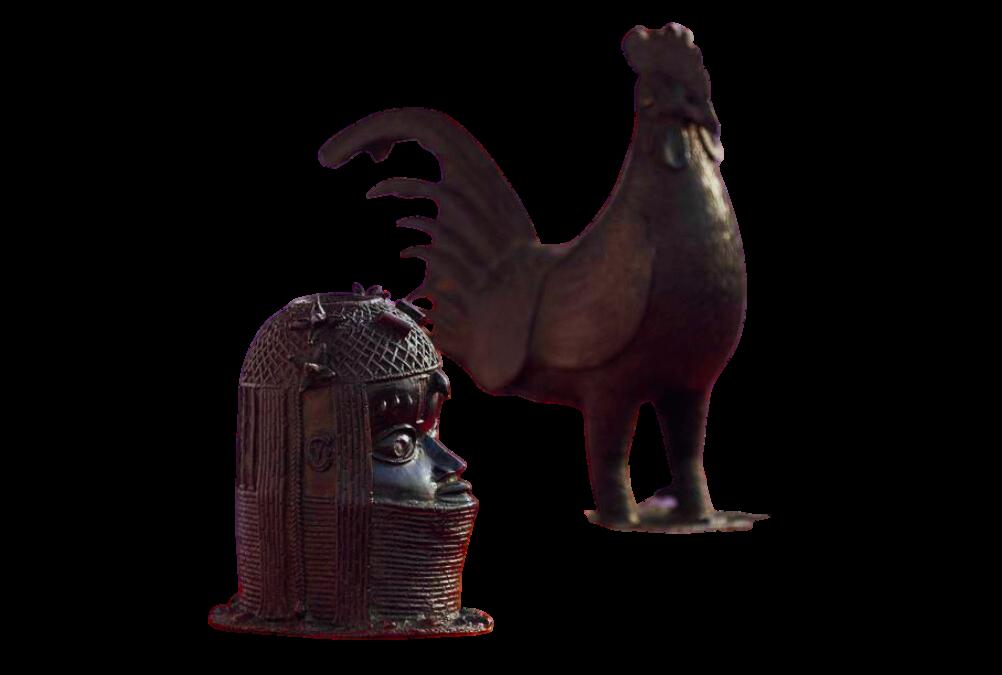
3 minute read
TRACES CULTURAL HISTORY of a ERASED
‘The Benin Bronzes’ is an iconic term used to refer to a group of sculptures and metal plaques created in the 13th century and onward by the guild of artisan in Edo and once decorated the royal palace of Benin kingdom, Nigeria. It better represents the artworks looted by the British troops in 1897, which have since disappeared around the world. Following several calls, a few of these looted artworks have been returned.
‘The African Origin of Civilisation: Myth or Reality’ is an exhibition that took place at the Metropolitan Museum of Art. It was packed with incredible artworks made by artists from Africa. This exceptional exhibition successfully paired artworks from Pharaonic Egypt with artworks from other parts of Africa. This approach was aimed to eradicate an existing preconception that Egyptian art is higher than art from the rest of Africa.
Advertisement
Artworks at the exhibition consisted of sculptures depicting animal and human figures, as well as fragments and relief works. Twenty-one African artworks were displayed, however, only five Benin Bronzes were amongst them. Here, the New York museum was trying to inform viewers about the story of looted objects and the recent calls for them. Unfortunately, they said nothing about the call for restitution aside helping to build a museum in Benin City and the possibility of loaning the works to the museum being built.
Okeke-Agulu, director of a programme in African Studies at Princeton University, expressed that the British museum Act of 1963 was put in place to prevent the museum from disposing of objects in their possession excerpt in pre-designated circumstances. So, it's this law that prevents the museum from disposing of the Benin bronzes. This Act of 1963 was enforced merely three years after 17 African nations gained independence from French, British and Belgium colonial forces.
When you do discussions with school children, which we had done, there is no memory of what Benin was, and Benin literally is Rome or Athens in Africa.
It’s one of the most heart-wrenching things to be able to go to a city with so much history and to hold fragments as a way to try to stitch back the incredible power of that place.
These objects were sacred shrine objects mostly, or palace objects or objects of governance and history which had a direct relationship to architecture, and the way in which architecture and art curates culture.
-David Adjaye, Ghanaian-British Architect.
David Adjaye, the Ghanaian-British architect and designer behind the new Benin Museum in Nigeria as well as Abu Dhabi’s Abrahamic Family House expressed that the looting of the Benin Bronzes was one aspect of the erasure of a prior cultural history that extended for 1000 years.
He also expressed there was a systematic discussion by British colonial forces to destroy the palaces, the spaces where the Benin Bronzes were kept, decontextualising the objects so they can be reassembled and reimagined in new forms as colonial tropes of war. This was Adjaye’s underlying support to his idea and task for the new museum project.
They have enacted laws when they are owned by states, or they have established non-written forms of behaviours if they are privately owned institutions answerable to wealthy people and boards of trustees.
It's not unlikely that that Act was enacted to prevent these decolonising nations from knocking on their doors.
The British destruction of Benin wiped out the collective memory of what the city was like. What is now inherited is a kind of post-war blockwork modernist city. This is contrary to everything to do with the prior civilisation. Having discussed with school children, there is no memory of what Benin was, and Benin is Rome or Athens in Africa, literally.
Excerpt from;
How the looted Benin Bronzes are symbolic of colonial cultural erasure
Bedirian R. (2022, March 07). ‘How the looted Benin Bronzes are symbolic of colonial cultural erasure’ The National News.
Retrieved from; https://www.thenationalnews.com/artsculture/art/2022/03/07/how-the-looted-benin-bronzes-are-symbolic-ofcolonial-cultural-erasure/
More than a century later, two Benin Bronzes were returned to the traditional palace in Benin city, Nigeria. A cockerel and head of an Oba sculpture were handed over to the Nigerian High Commission in October by the University of Aberdeen and Cambridge University's Jesus College. They were marked with a beautiful ceremony attended by traditional leaders. Although, Charles Edosonmwan, spokesman for the Oba palace in Benin City, expressed that some of the bronzes were kept as far away as New Zealand, the US and Japan, the return of these two bronzes raised hopes that more artefacts could finally be returned back to their ancestral home.
Excerpt from;
Nigeria’s looted Benin Bronzes returned more than a century late Murphy N. (2022, February 20). ‘Nigeria's looted Benin bronzes returned more than a century later’ The National News. Retrieved from; https://www.thenationalnews.com/world/africa/2022/02/20/nigeriaslooted-benin-bronzes-returned-more-than-a-century-later/



